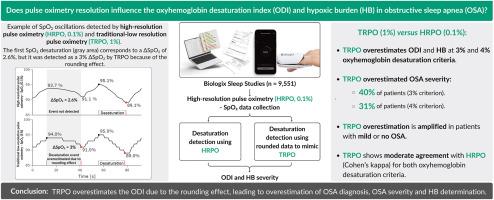血氧仪分辨率对阻塞性睡眠呼吸暂停患者血红蛋白去饱和事件和缺氧负担检测的影响。
IF 3.4
2区 医学
Q1 CLINICAL NEUROLOGY
引用次数: 0
摘要
背景:氧合血红蛋白去饱和事件(ODE)是阻塞性睡眠呼吸暂停(OSA)的检测和分类的主要因素。然而,脉搏血氧仪分辨率的变化可能会影响ODE的检测,从而影响血红蛋白去饱和指数(ODI)和缺氧负荷(HB)。我们假设,与高分辨率脉搏血氧仪(HRPO, 0.1%)相比,传统的低分辨率脉搏血氧仪(TRPO, 1%)对ODI和HB有影响。方法:从Biologix数据库中提取2023年2月至6月期间疑似OSA患者的连续未确定诊断性睡眠研究并进行分析。将Biologix血氧仪的HRPO数据与数学生成的TRPO数据进行比较。采用3%和4%的血红蛋白氧饱和度标准比较HRPO和TRPO之间的ODI和HB差异。效应量采用Cohen’s d进行评估。混淆矩阵、Bland-Altman图和Cohen’s Kappa用于评估HRPO和TRPO之间ODI测量的一致性。结果:共分析9551例诊断性睡眠研究。与HRPO相比,TRPO在3%去饱和标准下显著高估了ODI和HB: ODI3 %: 14.3 [6.9-25.3] vs. 21.1[12.0-34.0]事件/h;HB3 %: 23.5(10.2 - -46.1)和33.2(17.8 - -57.1)%最小/ h;结论:由于舍入效应,TRPO高估了ODI,从而导致对OSA诊断、OSA严重程度和HB测定的高估。本文章由计算机程序翻译,如有差异,请以英文原文为准。

Impact of oximetry resolution on detection of oxyhemoglobin desaturation events and hypoxic burden in patients with obstructive sleep apnea
Background
Oxyhemoglobin desaturation events (ODE) are major contributors to the detection and classification of obstructive sleep apnea (OSA). However, variations in pulse oximetry resolution may affect ODE detection and, consequently, the oxyhemoglobin desaturation index (ODI) and the hypoxic burden (HB). We hypothesized that traditional low-resolution pulse oximetry (TRPO, 1 %), which is designed to round up decimal points in the readout, compared to high-resolution pulse oximetry (HRPO, 0.1 %), impacts on ODI and HB.
Methods
Consecutive deidentified diagnostic sleep studies of patients with suspected OSA, recorded between February and June 2023, were extracted from the Biologix database and analysed. HRPO data from the Biologix oximeter was compared with mathematically generated TRPO data. ODI and HB differences between HRPO and TRPO were compared using oxyhemoglobin desaturation criteria of 3 % and 4 %. Effect sizes were assessed using Cohen's d. Confusion matrices, Bland-Altman plots and Cohen's Kappa were used to assess the agreement on ODI measurements between HRPO and TRPO.
Results
A total of 9551 diagnostic sleep studies were analysed. Compared to the HRPO, the TRPO significantly overestimated ODI and HB for the 3 % desaturation criterion: ODI3 %: 14.3 [6.9–25.3] vs. 21.1 [12.0–34.0] events/h; HB3 %: 23.5 [10.2–46.1] vs. 33.2 [17.8–57.1] % min/h; as well as the 4 % desaturation criterion (p < 0.0001 for all comparisons). Overestimation of ODI and HB was amplified among patients with no or mild forms of OSA.
Conclusion
TRPO overestimates the ODI due to the rounding effect, leading to overestimation of OSA diagnosis, OSA severity and HB determination.
求助全文
通过发布文献求助,成功后即可免费获取论文全文。
去求助
来源期刊

Sleep medicine
医学-临床神经学
CiteScore
8.40
自引率
6.20%
发文量
1060
审稿时长
49 days
期刊介绍:
Sleep Medicine aims to be a journal no one involved in clinical sleep medicine can do without.
A journal primarily focussing on the human aspects of sleep, integrating the various disciplines that are involved in sleep medicine: neurology, clinical neurophysiology, internal medicine (particularly pulmonology and cardiology), psychology, psychiatry, sleep technology, pediatrics, neurosurgery, otorhinolaryngology, and dentistry.
The journal publishes the following types of articles: Reviews (also intended as a way to bridge the gap between basic sleep research and clinical relevance); Original Research Articles; Full-length articles; Brief communications; Controversies; Case reports; Letters to the Editor; Journal search and commentaries; Book reviews; Meeting announcements; Listing of relevant organisations plus web sites.
 求助内容:
求助内容: 应助结果提醒方式:
应助结果提醒方式:


